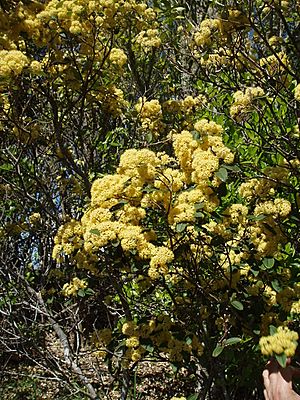Kumarahou facts for kids
Quick facts for kids Kumarahou |
|
|---|---|
 |
|
| Scientific classification | |
| Genus: |
Pomaderris
|
| Species: |
kumeraho
|
The kūmarahou (scientific name: Pomaderris kumeraho) is a special plant found only in the North Island of New Zealand. It's also known as gumdigger's soap. The name kūmarahou comes from the Māori language and means "shrub."
This plant can grow quite tall, up to four meters (about 13 feet). In September, it blooms with bright yellow flowers. It got the nickname "gumdigger's soap" because its flowers make a bubbly lather when rubbed with water. This was useful for people who needed to wash things, especially gumdiggers who collected kauri gum.
What is Kumarahou?
Kūmarahou is a unique shrub that belongs to the Pomaderris family. It's an endemic plant, which means it naturally lives and grows only in New Zealand and nowhere else in the world. This makes it a very special part of New Zealand's natural environment.
Traditional Uses of Kumarahou
For a long time, Māori people have used kūmarahou in their traditional Māori medicine. They believed it had many helpful properties.
- Herbal Teas: People often made a type of tea, called an infusion, from the leaves of the kūmarahou plant.
- Health Benefits: These infusions were thought to help with breathing problems, like coughs or chest issues. They were also used for skin problems, such as rashes or sores.
It's important to remember that while people have used kūmarahou for centuries, modern science is still studying its effects.

